|
Seasons
Author: Régis Bonnessée
Publisher: Libellud / Asmodee
Year: 2012
review by

| x |
|
|
|
|
|
|
|
|
|
|
|
|
|
|
|
|
|
|
|
|
|
|
|
|
|
|
|
|
|
|
|
|
|
|
|
|
|
|
|
|
|
|
|
|
|
|
|
|
|
|
|
|
|
|
|
|
|
|
|
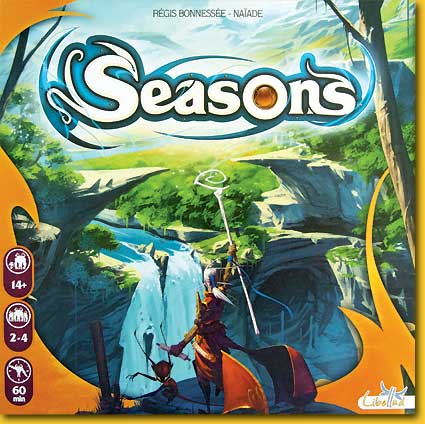 |
It doesn't really matter what we are in Seasons, but for the sake of completeness: we are magicians participating in a contest that lasts no less than 12 seasons. We use magical objects, and try to get as many allies as possible. These allies come in all shapes and sorts, but lovely or evil: we don't care, as long as they are on our team! Everything we do costs energy: a very realistic fact in this fantasy game. And if all goes well we are rewarded with crystals. The winner of this intensive, three year tournament is awarded the title Archmagician. And let's hope that he may enjoy this title for some time before he has to defend it during the next edition!
|
|
|
| x |
|
|
|
|
|
|
|
|
|
|
|
|
|
|
|
|
|
|
|
|
|
|
|
|
|
|
|
|
|
|
|
|
|
|
|
|
|
|
|
|
|
|
|
|
|
|
|
|
|
|
|
|
|
|
|
|
|
|
|
|
The central board depicts a wheel representing the twelve months and four seasons of each year. All players have their own player board where they can store their collected energy tokens, and their magical knowledge track that determines how many cards a player may possess. But the most important part of the game are the 50 different cards. There are objects (purple) and allies (orange) that can help us accomplish our goal, id est, to collect as many crystals as possible. At the start of the game everybody receives nine cards, which have to be divided into three sets of three cards: one set for every year. Three cards is not a lot: luckily there is ample opportunity during the game to collect more. All cards that have been played are placed in front of the players: they are not discarded unless specified. Sometimes the special ability of the card can be used every turn, or whenever a player chooses to activate the card, or when a specific condition has been met, but in other cases the effect only takes place once upon playing the card. The latter type of cards are lying around for the remainder of the game, doing nothing, but still counting toward the card limit! At the start of the game, the players are allowed to have zero cards in front of them, and they have to increase this limit during the game to a maximum of 15 cards.
|
|
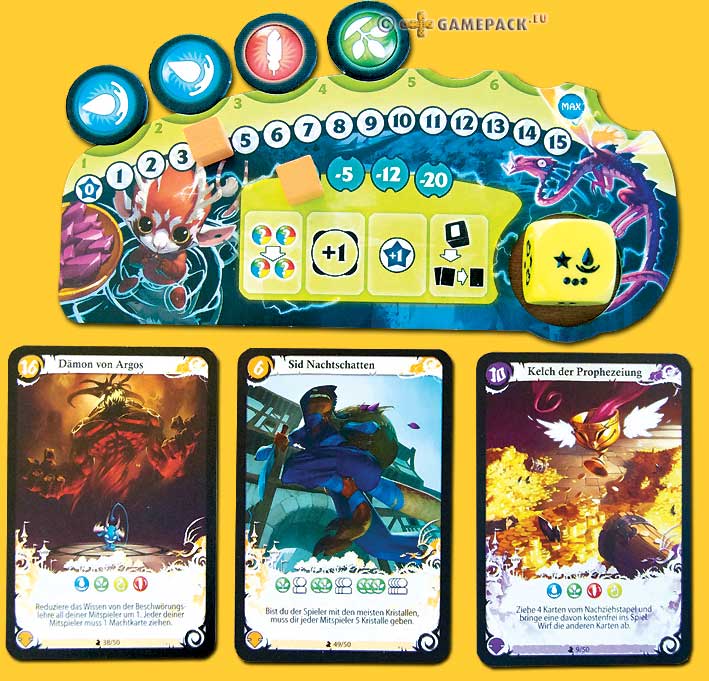 |
| x |
|
|
|
|
|
|
|
|
|
|
|
|
|
|
|
|
|
|
|
|
|
|
|
|
|
|
|
|
|
|
|
|
|
|
|
|
|
|
|
|
|
|
|
|
|
|
|
|
|
|
|
|
|
|
|
|
|
|
|
|
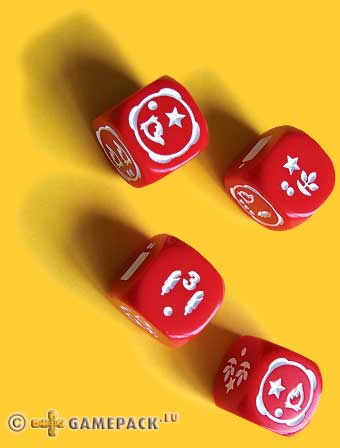
|
Every round the starting player throws a number of coloured dice (every season has its own colour). Every player chooses one die, and performs the depicted actions. The remaining die determines how many steps (months) the time marker progresses: 1 to 3. The dice show five different types of symbols that each correspond with an action. Often, more than one symbol is shown. Most frequent are the energy symbols. Energy is like money: it is used to 'pay' for cards. There are four types of energy: air, fire, water, earth. In each season, different symbols feature on the dice. A star symbol means that the player may progress one step on the magical knowledge track, allowing him to play more cards. A number on the die means 'crystals', and a card symbol indicates that the player may draw the top card from the deck.
|
|
|
|
Often a large circle is shown: this means that the player may exchange all his energy into crystals according to the current exchange rate. The exchange rate changes per season, and is depicted on the central board.
After three years the game is over. The players receive crystals for the cards in front of them, and, if applicable, additional bonus crystals when certain conditions are met. The player with the highest total on the crystal track is appointed Archmagician.
|
|
|
| x |
|
|
|
|
|
|
|
|
|
|
|
|
|
|
|
|
|
|
|
|
|
|
|
|
|
|
|
|
|
|
|
|
|
|
|
|
|
|
|
|
|
|
|
|
|
|
|
|
|
|
|
|
|
|
|
|
|
|
|
 |
| x |
| x |
| x |
 |
|
|
|
|
|
|
|
|
|
|
|
|
|
|
|
|
|
|
|
|
|
|
|
|
|
|
|
|
|
|
|
|
|
|
|
|
|
|
|
|
|
|
|
|
|
|
|
|
|
|
| Seasons leans heavily on the various cards. To be able to understand the game, some examples of these cards are necessary. Some cards only have an effect the moment they are played: take four energy, 20 crystals, three cards, discard three cards and receive crystals in return, et cetera. Even though they are not effective anymore after performing the action, they still remain in front of the player, and they count toward the card limit! You might get in trouble if you play too many of these cards without increasing your card limit at the same time. |
|
|
| x |
|
|
|
|
|
|
|
|
|
|
|
|
|
|
|
|
|
|
|
|
|
|
|
|
|
|
|
|
|
|
|
|
|
|
|
|
|
|
|
|
|
|
|
|
|
|
|
|
|
|
|
|
|
|
|
|
|
|
|
 |
|
The best cards are those with a permanent effect, such as a more favourable exchange rate when converting energy to crystals. Other examples are a permanent discount of one energy token when playing a card, three crystals when playing a card, or three crystals if you end your turn with four or more energy in stock. Of course some of the cards are directed at the opponents: the character Figrim orders all players to give the owner of the card one crystal every time the marker reaches a new season (so, up to 12 times during the game!). There are cards that you have to activate yourself: the character Kairn states that every time you pay one energy token, all opponents have to discard four crystals. If you manage to activate this card every turn, this will give your opponents a serious headache! |
|
|
| x |
|
|
|
|
|
|
|
|
|
|
|
|
|
|
|
|
|
|
|
|
|
|
|
|
|
|
|
|
|
|
|
|
|
|
|
|
|
|
|
|
|
|
|
|
|
|
|
|
|
|
|
|
|
|
|
|
|
|
|
|
Despite all the different cards, Seasons is not a very complex game. It comes down to carefully studying your cards (and you have only three of them at the start of the game), and let this determine which dice you choose to collect the required types of energy. At the beginning of the game, the players are allowed to have zero cards in front of them, so, this is the first item to be addressed. It is a bit like throwing a six in Ludo: as long as you don't succeed, there is actually not much you can do in the game. Expanding the number of cards you may have in front of you can be achieved by choosing a die depicting a star symbol, and then play a card that allows you to increase your limit even further. But, if you are last in line and you can't get your hands on dice with star symbols, there is a way out: players are allowed to take three bonus actions during the game, at the expense of some crystals. One of these bonus actions is to take one step on the magical knowledge track: problem (temporarily) solved.
|
|
 |
|
|
| x |
|
|
|
|
|
|
|
|
|
|
|
|
|
|
|
|
|
|
|
|
|
|
|
|
|
|
|
|
|
|
|
|
|
|
|
|
|
|
|
|
|
|
|
|
|
|
|
|
|
|
|
|
|
|
|
|
|
|
|
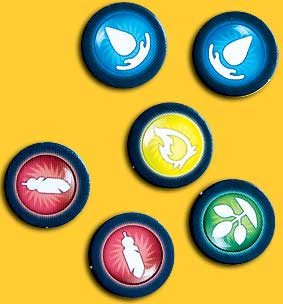 |
|
Many of the cards work synergistically. Or they counteract each other. If you start with a set of nine cards, you have to be lucky if you want to be able to make something out of it. Therefore, the drafting option is advisable for the more experienced players: everybody chooses one card from their hand, and then passes the remaining cards on to his neighbour, and so on, until everybody has nine cards. This way, instead of only your own nine cards, you get to glimpse all the cards that are in the game. This makes it possible to choose a certain direction or strategy. Then, you divide these nine cards into three sets for the three years: cheap cards with convenient actions and discounts for the first year, and expensive cards that yield mainly crystals and do nothing else for the last year. |
|
|
| x |
|
|
|
|
|
|
|
|
|
|
|
|
|
|
|
|
|
|
|
|
|
|
|
|
|
|
|
|
|
|
|
|
|
|
|
|
|
|
|
|
|
|
|
|
|
|
|
|
|
|
|
|
|
|
|
|
|
|
|
| There are multiple ways to get crystals: exchanging energy for crystals is the most obvious one. To pursue this strategy, useful cards are ones that give you a better exchange rate, or ones that provide extra energy storage (this is normally limited to seven tokens) so you can strike a bigger deal. Stealing crystals from opponents is also effective, and there are many cards to aid you there. And last but not least, there are cards that award you crystals if you meet certain conditions: when paying energy, when discarding cards, for each purple card in your collection, or when you are the player with the highest number of cards at the end of the game. |
|
|
| x |
|
|
|
|
|
|
|
|
|
|
|
|
|
|
|
|
|
|
|
|
|
|
|
|
|
|
|
|
|
|
|
|
|
|
|
|
|
|
|
|
|
|
|
|
|
|
|
|
|
|
|
|
|
|
|
|
|
|
|
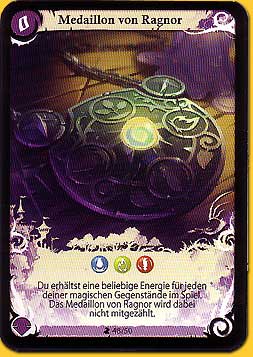 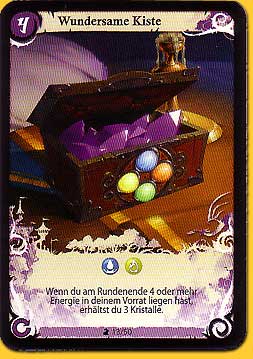  |
| x |
|
|
|
|
|
|
|
|
|
|
|
|
|
|
|
|
|
|
|
|
|
|
|
|
|
|
|
|
|
|
|
|
|
|
|
|
|
|
|
|
|
|
|
|
|
|
|
|
|
|
|
|
|
|
|
|
|
|
|
|
If you take the time to carefully examine the cards, something that you tend to forget during the game, you will notice that they are beautifully illustrated. A beautiful fantasy world, the wood of Argos in Xidit to be precise, has been created here. The names of the cards are very imaginative, and often this helps to recognize and remember their function more easily. The basic characteristics of the cards are summarised in clear icons, and their function is described in text. For those who need additional explanation: the cards are numbered for easy reference, and a full description can be found in the rule book. Ample praise: even how the features of the cards influence each other, something that tends to be neglected in other games, is carefully described. Because of the considerable amount of text on the cards it is essential to use an edition in a language that all players comprehend. A simple A4 sheet with translations is a nice ad hoc solution, but it won't work in the long run.
|
|
|
| x |
|
|
|
|
|
|
|
|
|
|
|
|
|
|
|
|
|
|
|
|
|
|
|
|
|
|
|
|
|
|
|
|
|
|
|
|
|
|
|
|
|
|
|
|
|
|
|
|
|
|
|
|
|
|
|
|
|
|
|
|
On one hand you can determine a strategy based on your starting cards. But on the other hand you depend largely on the dice, on the cards that you happen to draw later on in the game, and on the tricks your opponents play on you. There are games where you just can't get your motor running. But especially -but definitely not only!- for those who enjoy the fantasy theme, the game is good enough not to mind this too much!
© 2013 Barbara van Vugt
Seasons, Régis Bonnessée, Libellud / Asmodee, 2012 - 2 to 4 players, 14 years and up, 60 minutes
|
|
|
  |
|
|
|
|
|
|
|
|
|
|
|
|
|
|
|
|
|
|
|
|
|
|
|
|
|
|
|
|
|
|
|
|
|
|
|
|
|
|
|
|
|
|
|
|
|
|
|
|
|
|
  |
|
|
|
|
|
|
|
|
|
|
|
|
|
|
|
|
|
|
|
|
|
|
|
|
|
|
|
|
|
|
|
|
|
|
|
|
|
|
|
|
|
|
|
|
|
|
|
|
|
|
  |
|
|
|
|
|
|
|
|
|
|
|
|
|
|
|
|
|
|
|
|
|
|
|
|
|
|
|
|
|
|
|
|
|
|
|
|
|
|
|
|
|
|
|
|
|
|
|
|
|
|
  |
|
|
|
|
|
|
|
|
|
|
|
|
|
|
|
|
|
|
|
|
|
|
|
|
|
|
|
|
|
|
|
|
|
|
|
|
|
|
|
|
|
|
|
|
|
|
|
|
|
|
  |
|
|
|
|
|
|
|
|
|
|
|
|
|
|
|
|
|
|
|
|
|
|
|
|
|
|
|
|
|
|
|
|
|
|
|
|
|
|
|
|
|
|
|
|
|
|
|
|
|
|
| x |
|
|
|
|
|
|
|
|
|
|
|
|
|
|
|
|
|
|
|
|
|
|
|
|
|
|
|
|
|
|
|
|
|
|
|
|
|
|
|
|
|
|
|
|
|
|
|
|
|
|
|
|
|
|
|
|
|
|
|
| x |
|
|
|
|
|
|
|
|
|
|
|
|
|
|
|
|
|
|
|
|
|
|
|
|
|
|
|
|
|
|
|
|
|
|
|
|
|
|
|
|
|
|
|
|
|
|
|
|
|
|
|
|
|
|
|
|
|
|
|
 |
|
|
|
|
|
|
|
|
|
|
|
|
|
|
|
|
|
|
|
|
|
|
|
|
|
|
|
|
|
|
|
|
|
|
|
|
|
|
|
|
|
|
|
|
|
|
|
|
|
|
 |
|
|
|
|
|
|
|
|
|
|
|
|
|
|
|
|
|
|
|
|
|
|
|
|
|
|
|
|
|
|
|
|
|
|
|
|
|
|
|
|
|
|
|
|
|
|
|
|
|
|
| x |
|
|
|
|
|
|
|
|
|
|
|
|
|
|
|
|
|
|
|
|
|
|
|
|
|
|
|
|
|
|
|
|
|
|
|
|
|
|
|
|
|
|
|
|
|
|
|
|
|
|
|
|
|
|
|
|
|
|
|
 |
|
|
|
|
|
|
|
|
|
|
|
|
|
|
|
|
|
|
|
|
|
|
|
|
|
|
|
|
|
|
|
|
|
|
|
|
|
|
|
|
 |
|
|
|
|
|
|
|
|
|
|
|
|
|
|
|
|
|
|
|
|
|
|
|
|
|
|
|
|
|
|
|
|
|
|
|
|
|
|
|
|
|
|